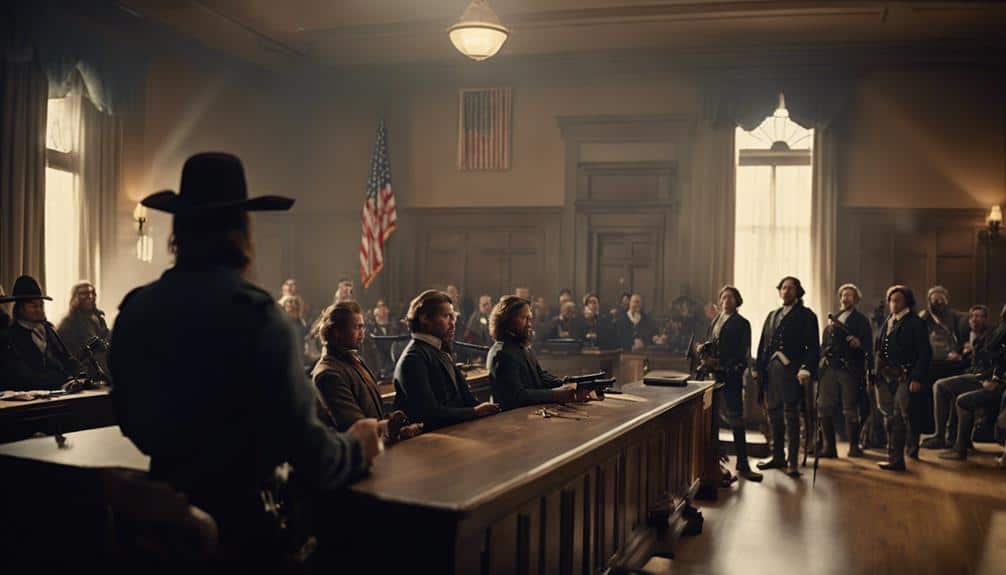You might wonder if stun guns fall under the
Second Amendment‘s umbrella, and they absolutely do! Back in 2016, the
Supreme Court ruled in *Caetano v. Massachusetts* that stun guns are protected just like traditional firearms. This case involved a woman using a stun gun for
self-defense against an abusive ex. Massachusetts tried to ban them, but the Supreme Court stood firm, saying non-lethal tools for
personal safety should be included. So, your right to bear arms does extend to modern self-defense gadgets, giving you more options to stay safe. Curious about how this impacts future laws? Keep exploring!
Historical Context
When diving into the
historical context of the
Second Amendment, it is vital to understand the fears and motivations of the late 18th century. Back then, people were genuinely scared of
government tyranny. They believed that owning weapons was essential for
self-defense and for forming
militias. These fears led to the
ratification of the Second Amendment in 1791, anchoring the idea that citizens needed to be armed to protect their newfound freedom. Even though the types of weapons have evolved, the principle remains the same. For instance, modern
self-defense tools like stun guns are now part of the conversation.
Fast forward to today, you might wonder how this historical context applies to modern self-defense tools like stun guns. Well, the
Supreme Court’s 2008 decision in *District of Columbia v. Heller* clarified that Second Amendment rights are
individual rights. This means it’s not just about militias; it’s about you and your right to self-defense.
In the *Caetano case*, the court highlighted the absurdity of excluding stun guns from the definition of “bearable arms” just because they didn’t exist in the 18th century. That’s like saying you can’t use a smartphone because they didn’t have those back then! Legal debates still rage on about what counts as “arms” under the Second Amendment, but understanding its historical context helps shape these discussions.
Case Background
Imagine being
Jaime Caetano, who carried a
stun gun to protect herself from an abusive ex-boyfriend, only to be arrested because Massachusetts law banned civilian stun guns. When the state court said stun guns weren’t covered by the
Second Amendment, it sparked a legal showdown that reached the Supreme Court. The justices stepped in, proclaiming that the right to bear arms includes modern self-defense tools like
stun guns, making this case a pivotal moment for
personal safety rights. This decision underscores the importance of understanding self-defense laws and local regulations to avoid legal repercussions. Additionally, the ruling highlighted the relevance of
non-lethal defense tools in contemporary society.
Case Overview Summary
In 2016, the Supreme Court addressed a critical issue of
self-defense and the
Second Amendment in *Jaime Caetano v. Massachusetts*. You might find it surprising, but this case wasn’t about traditional firearms; it was about stun guns.
Jaime Caetano was in a tough spot, dealing with an
abusive ex-partner. She carried a
stun gun for protection, but
Massachusetts law said that was a no-go. So, she got convicted for having it. Caetano’s stun gun was similar to the
Fang Keychain Stun Gun, a compact and discreet self-defense tool.
The Massachusetts Supreme Judicial Court initially ruled that stun guns were not covered by the Second Amendment. But the
U.S. Supreme Court didn’t agree. They vacated that decision and said, “Hold on, modern self-defense tools like stun guns are protected too.” This wasn’t just about one woman’s right to carry a stun gun; it was about affirming that the Second Amendment covers more than just old-school weapons from the 18th century.
The ruling emphasized how important self-defense rights are, especially for folks in
vulnerable situations like Caetano. By linking this case to the precedent set by *District of Columbia v. Heller*, the Court broadened the interpretation of what arms are considered protected under the Second Amendment.
Legal Context Analysis
The legal intricacies surrounding
Jaime Caetano v. Massachusetts plunge into some pretty intense territory. Imagine you’re Jaime, trying to protect yourself from an
abusive ex with a
stun gun, only to get convicted because Massachusetts law says that stun guns aren’t covered by the
Second Amendment. Frustrating, right?
So, the
Massachusetts Supreme Judicial Court thought stun guns were too dangerous and not “in common use.” They didn’t see them as “bearable arms” under the Second Amendment. But hold on, the U.S. Supreme Court had a different take.
In 2016, the Supreme Court stepped in and gave Massachusetts a reality check. They said, “Hey, the Second Amendment isn’t just about old-school muskets; it covers
modern self-defense weapons, too.” This was a big deal, folks! The Court pointed out that the right to bear arms includes all
bearable arms, which means stun guns are in the mix.
The Supreme Court’s ruling also shot down the Massachusetts court’s reasoning, calling it inconsistent with the landmark *District of Columbia v. Heller* decision. This case really highlights how
self-defense rights evolve over time, showing that modern tools like stun guns deserve protection too.
Legal Issues
When you think about the
Second Amendment, you probably picture muskets and old-timey pistols, right? But the Supreme Court’s ruling in *Caetano v. Massachusetts* shakes things up, saying
modern weapons like stun guns are also protected. This decision isn’t just about gadgets; it’s a huge nod to our evolving
right to self-defense, making you wonder what other weapons could be next in line for protection. For instance, items like the
SAL Stun Gun with Alarm and Flashlight are now considered protected under this ruling.
Historical Context of Arms
Understanding the historical context of arms within the framework of the Second Amendment is essential for grasping its legal implications. The phrase “bear arms” isn’t just about firearms; it covers all kinds of weapons for offense or defense, leading to broader interpretations. The framers didn’t limit “arms” to those from 1791, so modern self-defense tools, like stun guns, fit right in.
Legal precedents back this up. In *District of Columbia v. Heller* (2008), the court said the right to bear arms includes individual ownership for self-defense. This has helped in understanding contemporary weapons. Then, *Caetano v. Massachusetts* (2016) came along and confirmed that even modern bearable arms, like stun guns, are protected, despite their absence back in the day.
The “common use” test is super important here. It checks if a weapon is widely used by law-abiding citizens for lawful purposes. If it is, it’s likely protected under the Second Amendment.
| Case |
Year |
Key Points |
| District of Columbia v. Heller |
2008 |
Right to bear arms includes self-defense |
| Caetano v. Massachusetts |
2016 |
Protections extend to modern weapons like stun guns |
| Framers’ Intent |
1791 |
Didn’t limit “arms” to those existing in 1791 |
| Common Use Test |
N/A |
Assesses if a weapon is widely used for lawful purposes |
| Modern Self-Defense Tools |
N/A |
Includes items like stun guns under the Second Amendment |
Self-Defense and Modern Weapons
Many
legal complexities surround the use of modern weapons for
self-defense, particularly
stun guns. When you think about it, the
Second Amendment isn’t just about muskets and flintlocks. In *Caetano v. Massachusetts*, the Supreme Court ruled that stun guns are
bearable arms, protected under the Second Amendment. They emphasized that self-defense tools need to keep up with the times. For instance,
disguised stun guns, like those hidden in everyday items such as cell phones or lipsticks, offer a discreet and practical way to guarantee
personal safety.
Imagine you’re Jaime Caetano, dealing with an abusive ex. You’d want every tool at your disposal, right? Stun guns offer a
non-lethal way to protect yourself, making them essential for vulnerable individuals. The Court’s decision was clear: the right to self-defense doesn’t expire just because a weapon is modern. That means even though stun guns weren’t around when the Constitution was written, they still count.
These ruling highlights the
evolving nature of self-defense needs. It’s not just about what weapons were used back in the day but about what we need today. Sure, there’s ongoing debate about balancing
individual rights and state regulations, but the key takeaway is simple. You have a right to defend yourself, and modern weapons like stun guns are part of that right.
Supreme Court Ruling
In a
landmark decision, the
U.S. Supreme Court ruled in *Caetano v. Massachusetts* (2016) that
stun guns are indeed protected by the
Second Amendment. You might think, “Wait, what?” But yes, this ruling means that modern
self-defense tools like stun guns fall under the protection of the Second Amendment, even though they weren’t around when the Amendment was first written. The Supreme Court emphasized that the Second Amendment applies to all arms that are commonly used today. So, even if George Washington didn’t have a stun gun, you can still have one for individual self-defense. For example, the
SAL Pink Stun Gun offers a high-voltage shock and other safety features for effective
personal protection. This ruling
overturned the Massachusetts Supreme Judicial Court’s decision, which had decided that stun guns were too dangerous and not in
common use.
Just imagine, you now have the backing of the Supreme Court to carry a stun gun for your protection. This decision builds on the precedent set by *District of Columbia v. Heller* (2008), which recognized your right to bear arms for self-defense. The Court has made it clear:
modern weapons are part of your self-defense strategy, and they’re not going anywhere. So, if you want a stun gun, you’re in good company.
Justices’ Opinions
Let’s talk about what
Justices Alito and Thomas had to say. They were pretty fired up, arguing that
stun guns are essential for
self-defense, especially for those who feel most at risk. They made it clear that the
Second Amendment should cover these modern tools, not just old-fashioned muskets. Considering that modern stun guns, like the
Stun Pen Pink Stun Gun, are designed to be both stylish and effective, it makes sense that their use would be protected. This is especially important given the lifetime warranty and commitment to customer satisfaction that come with such products.
Alito and Thomas’ Viewpoints
Justices Alito and Thomas’ viewpoints sharply illuminate their strong belief that
stun guns fall under the
Second Amendment‘s protections. They argue that these modern
self-defense tools should be included under constitutional law, just like traditional firearms. Justice Alito went so far as to criticize the
Massachusetts Supreme Judicial Court for excluding stun guns from Second Amendment protections. He found their interpretation overly restrictive and inconsistent with the broader implications of the landmark
Heller decision. Notably, the
100 Million Volt Bouncer Stun Gun, a popular self-defense tool, exemplifies the type of
modern weaponry that could be covered under this broader interpretation.
Alito and Thomas didn’t hold back. They underscored the absurdity of denying protections to
non-lethal self-defense weapons, like stun guns, which are becoming more common for
personal protection. Imagine needing a self-defense tool but being told it’s not covered just because it’s non-lethal—a bit ridiculous, right? Their opinions highlighted that the right to bear arms extends to weapons serving modern self-defense purposes, regardless of whether these weapons existed when the Second Amendment was ratified.
Their strong stance suggests they’re ready to challenge
state restrictions on non-traditional weapons. This could set a precedent for future cases involving the regulation of self-defense tools. It’s clear they believe in
broadening the interpretation of the Second Amendment to fit today’s needs.
Self-Defense Necessity Highlighted
Self-defense stands as a paramount concern in the discussion of Second Amendment rights, especially in the opinions of Justices Alito and Thomas. They emphasize the critical role of stun guns as essential self-defense tools, especially for vulnerable individuals like those facing domestic abuse. It’s absurd, they argue, to ban these less lethal self-defense options because it puts state disarmament over individual safety. Alito’s concurrence in *Caetano v. Massachusetts* underscores that self-defense is a fundamental right. He stresses that the Second Amendment should extend to modern weapons like stun guns. Imagine being in a threatening situation and only having outdated means to protect yourself—that’s just not right. The justices think the same. They argue that limiting Second Amendment rights to only historically common arms undermines your ability to protect yourself with current self-defense technologies. Stun guns like the
FANG Pink Stun Gun offer an effective and non-lethal means of protection, making them a valuable tool for personal safety.
To make this clear, consider these points:
- Self-defense must evolve: New threats require new means of protection.
- Critical role of non-lethal weapons: Stun guns offer safety without lethal force.
- Individual safety first: Prioritizing your safety over strict state regulations.
Major Legal Precedents
When exploring the major legal precedents surrounding
stun guns and the
Second Amendment, it is essential to start with the landmark case *District of Columbia v. Heller*. This 2008 case confirmed that the Second Amendment protects an individual’s right to possess firearms for
self-defense, setting the stage for future interpretations about weapon types, including stun guns. Think of it like this: Heller is the bedrock, the foundation on which later cases build. Stun guns, such as the
Hot Shot Stun Gun, have specific features like a built-in rechargeable battery and a safety switch that make them effective for self-defense.
Moving to *McDonald v. Chicago* in 2010, the Supreme Court ruled that the Second Amendment rights recognized in Heller apply to states through the
Fourteenth Amendment. This decision was like setting off fireworks—it opened the door for challenges to state-level bans.
Now, *Caetano v. Massachusetts* in 2016 brought stun guns into the spotlight. The Supreme Court clarified that
modern bearable arms, such as stun guns, are protected under the Second Amendment. Picture it like adding the final puzzle piece that shows the whole picture.
Don’t forget the ongoing *Martel v. Healey* case, which is challenging Massachusetts’
stun gun ban. If successful, it could set another precedent, solidifying the inclusion of
electrical weapons under Second Amendment protections. The legal landscape here is evolving, and you’re right in the middle of it!
Self-Defense Rights
Protection against threats is a fundamental aspect of self-defense rights, and the Supreme Court’s ruling in *Caetano v. Massachusetts* makes that crystal clear. Imagine you’re facing danger, and all you’ve got is a stun gun. You should feel secure knowing that the Second Amendment has got your back. The ruling confirmed that stun guns are bearable arms, protected under your right to possess weapons for self-defense.
Jaime Caetano’s case is a perfect example. She carried a stun gun to protect herself from an abusive ex-boyfriend. Her situation highlights why self-defense tools matter, especially for vulnerable individuals. The Massachusetts Supreme Judicial Court initially said stun guns weren’t protected, but the U.S. Supreme Court overturned that. They made it clear: self-defense rights extend to modern weapons, not just those around when the Amendment was written.
Here’s what you need to remember:
- Stun guns are considered bearable arms under the Second Amendment.
- The right to self-defense includes modern weapons.
- Vulnerable individuals, like Jaime Caetano, need effective protection.
Justice Alito’s words hit home: you need a reliable way to defend yourself against threats. The
Caetano decision guarantees you’ve got that right.
Modern Weaponry
Modern weaponry has considerably broadened the scope of the
Second Amendment, bringing new tools of
self-defense into the
legal spotlight. When you think of the Second Amendment, you probably picture muskets and traditional firearms. But thanks to the
U.S. Supreme Court‘s ruling in *Caetano v. Massachusetts*, you can add
stun guns to that list. This decision confirmed that stun guns are
bearable arms protected under the Second Amendment. It’s a game-changer, showing that modern weapons, even those not around when the Amendment was ratified, have a place in today’s legal landscape.
The ruling aligns perfectly with the precedent set by *District of Columbia v. Heller*, which stated the right to bear arms includes self-defense tools used in contemporary contexts. Imagine, you’re no longer limited to the weapons of the past. Now, stun guns, as a non-lethal self-defense option, are gaining acceptance and legal protection. But, it’s not all smooth sailing. Some states still have bans on stun guns, sparking ongoing debates about balancing self-defense rights with
public safety.
Public Safety Concerns

While the Supreme Court’s recognition of stun guns as protected under the Second Amendment marks a significant shift in self-defense rights, it also brings forward serious public safety concerns. You might think stun guns are a safer alternative to firearms, but there’s more to evaluate. The use of stun guns has been linked to at least 48 deaths in incidents involving police, raising alarms about their true lethality.
Despite being marketed as less lethal, a 2015 Washington Post investigation highlighted the risks associated with Tasers. These devices can still cause serious harm or even death, making their safety questionable. The Department of Justice reported that the number of local police departments authorizing Tasers skyrocketed from 7% in 2000 to 81% in 2013. That’s a huge jump! But it does show a growing acceptance of these devices despite the concerns.
Critics argue that stun guns can escalate volatile situations. Instead of calming things down, they might lead to more violence and injury. Massachusetts defends its ban on stun guns as a necessary public safety measure, emphasizing ongoing safety concerns.
- Stun guns linked to 48 deaths in police incidents.
- 2015 report: Tasers can cause serious harm or death.
- Massachusetts ban: A step for public safety?
Future Implications
The
Supreme Court’s ruling in *Caetano v. Massachusetts* could change the game for
self-defense. By classifying
stun guns as bearable arms protected under the
Second Amendment, you might soon see a broader range of self-defense tools at your disposal. With
legal challenges like *Martel v. Healey* on the horizon, the landscape of what’s considered “arms” is shifting. This could mean that non-traditional weapons, such as stun guns, might gain more acceptance and legal backing.
Imagine a future where state and local bans on stun guns face increased scrutiny. As these devices become more common, they could be viewed as essential for self-defense, much like firearms. This evolving interpretation of the Second Amendment suggests that as stun guns gain popularity, they’ll likely see greater protections against restrictions.
But what about
public safety? The debate isn’t going away. You’ll see ongoing discussions about balancing
individual rights with
community safety. As lawmakers and courts grapple with these issues, the way we perceive and regulate self-defense tools will keep evolving. So, whether you’re for or against stun guns, one thing’s clear: the conversation is far from over.
Frequently Asked Questions
Does the Second Amendment Apply to Stun Guns?
You won’t believe it, but yes, the Second Amendment covers stun guns! This means these non-lethal self-defense weapons are constitutionally protected, despite state regulations. Stun gun legality is essential for public safety and modern constitutional interpretation.
What Guns Are Not Protected by the 2nd Amendment?
You’re wondering which guns aren’t protected by the Second Amendment. Stun gun legality varies, but non-lethal arms like these often face state regulations. Constitutional debates focus on public safety, limiting self-defense weapons like machine guns and short-barreled shotguns.
Does the 2nd Amendment Apply to Self-Defense?
Yes, the Second Amendment applies to self-defense. Self-defense laws, legal interpretations, and historical context confirm this. State regulations and public perception emphasize personal safety, ensuring the right to bear arms for protection is maintained.
What Does the Second Amendment Not Protect?
You can’t expect the Second Amendment to cover everything! It doesn’t protect stun gun legality or other non-lethal weapons if they raise public safety concerns. State regulations, historical context, and self-defense laws heavily influence what’s protected.










One Response